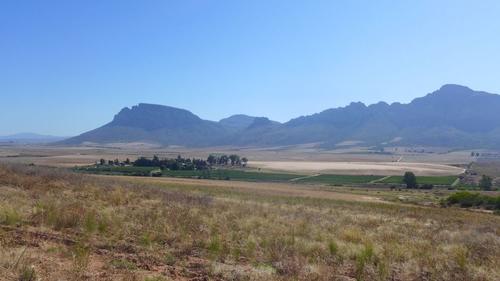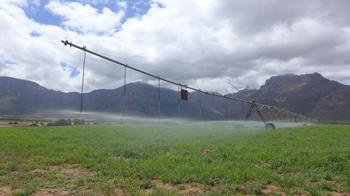Geographical introduction to the Krom Antonies catchment
In the following paragraphs you will find an introduction into the Krom Antonies catchment in South Africa and its main geographical features. Click on the different topics to get more information!
Mean annual rainfall in the catchment totals 300–600 mm and follows a strong orographic gradient. Temperature averages around 17°C. January is the month reviewing the lowest rainfall amount, while June is the wettest month. Concomitantly June and July are the coldest month, monthly temperature averages around 12°C. Thus, the climate is classified as a typical Mediterranean-type winter rainfall climate with mild winters. The climate is classified as Csa following Köppen and Geiger.
Most of the year – especially in the growing season – evaporations exceeds rainfall.
The valley floor of the Krom Antonies catchment consists of quaternary alluvial deposits. They cover a clay layer. In the West, East and South, the catchment is surrounded by a mountain system. These mountains are part of the Table Mountain Series, an Ordovitian to lower Carbonferous sandstone, which is mainly quartzitic. It is underlain by late Precambrian meta-sedimentary rocks, which are part of the Malmsbury group. The downstream areas of the Krom Antonies catchment are part of the Sandveld's quaternary to tertiary unconsolidated deposits. A granite pluton intrusion is located at the fault line crossing the catchment in Southwest–Northeast direction.
The soils are typically grey sandy soils. Nutritent values are low. They might be classified as lithosols and lithic soils on the steeper slopes and lime soils in the valley bottom.
Land cover in the Krom Antonies catchment: Fallow in the foreground, irrigated fields and natural wetlands in the middle-ground and natural Fynbos vegetation in the background
Image Credit: K. Ebermann, 2014
The floodplains of the Krom Antonies River are covered with wetland vegetation. The gentle valley bottom is mainly used for agricultural purposes; on some of the non-used areas Sand Fynbos might be found. Sand Fynbos is the typical natural vegetation of quartzitic sandy soils. On nutrition poor soils on the slopes, sandstone mountains, Sandstone Fynbos grows. The Malmsbury group areas are in general more nutritious and have higher clay content. They are covered by Renosterveld shrubland vegetation.
All natural vegetation types in the Krom Antonies catchment are part of the Cape Floral Kingdom, the smallest floristic kingdom of the World. One typical feature is its fire resistivity.
The main agricultural product of the catchment is potato, mainly cultivated on large circular fields, which are irrigated by center pivots. In addition, grapes, vine and rooibos are grown.
The Krom Antonies River is a tributary of the Verlorenvlei River, which is part of the Verlorenvlei catchment. The Verlorenvlei is an estuary system and a natural wetland in the Sandveld.
Groundwater – the basis of the irrigation farming in the area – is extracted from wells. In addition, runoff dams and small dams in the Krom Antonies River are used to collect water for irrigation.
The catchment is part of the G30D Quarternary catchment and therefore managed within the Water Management Area 17, the Olifants/Doorn water management area. A Water User Association was established in the catchment in 2007.



